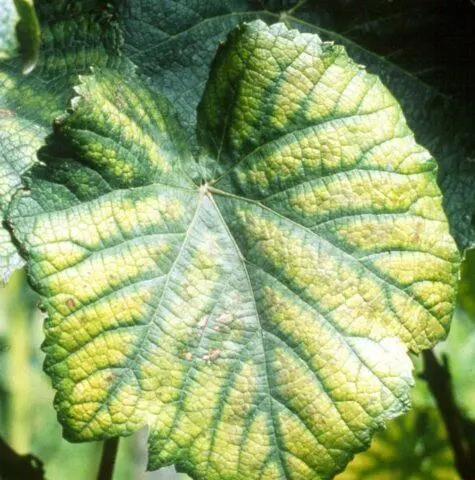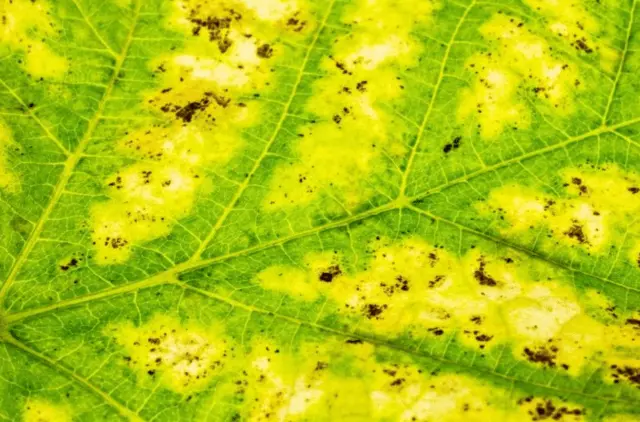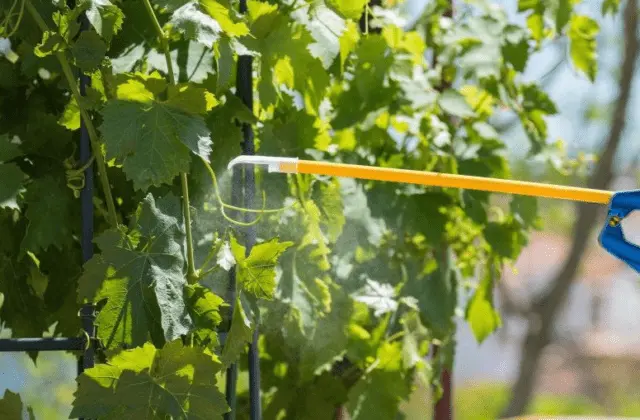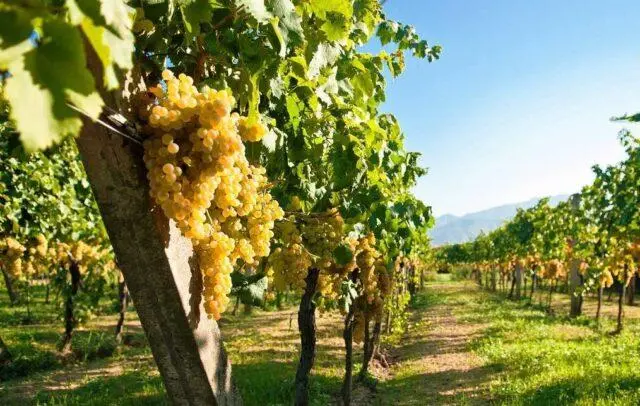Contents
Chlorosis of grapes is a disease, the main symptom of which is yellowing of the leaves due to the destruction of the green pigment – chlorophyll. Violation may be associated with a deficiency of trace elements or with a virus infection. In the first case, foliar and root top dressing is carried out, in the second case, the bush has to be destroyed.
What is dangerous chlorosis
Chlorosis is a general name for diseases that have similar symptoms but different causes. It affects the leaves of grapes and other crops. It can also spread to shoots and clusters. The danger of chlorosis is that it can lead to several adverse effects:
- malnutrition of the roots;
- lagging bushes in development;
- yield reduction;
- deterioration of resistance to adverse conditions, diseases and pests.
When the first signs of chlorosis are detected, it is necessary to clarify the cause, since the treatment depends on this. Next, you need to treat the grape bushes with foliar dressings, fungicides, or solutions prepared independently according to folk recipes.
Causes of grape chlorosis
The causes of grape chlorosis may be associated with infection and a lack of various trace elements. In the first case, the virus penetrates through the soil or through peddlers (pests). As a result, saturated green spots appear on the leaf plates. In this case, the plant can eventually infect neighboring bushes, which is dangerous for the entire vineyard and other crops.
Non-infectious chlorosis of grapes is associated with a lack of certain elements. It is especially often observed on heavy clay soils, infertile soils with a high pH (7,5 or more), i.e. in an alkaline environment. At the same time, malnutrition of grapes may be associated with a lack of one or several trace elements at once – sulfur, magnesium, zinc, nitrogen and others.
The main reasons provoking the development of the disease include:
- soil alkalinity;
- clay soil;
- increased content of calcium hydroxide (slaked lime);
- damage to shrubs by carriers of the disease (soil nematodes, worms);
- unbalanced top dressing;
- prolonged unfavorable weather conditions.
There are also objective causes of grape chlorosis. For example, certain varieties are more susceptible to this disease than others. These include:
- Riesling;
- Black sultanas;
- Pinot Fran;
- Saperavi;
- Pinot Noir;
- Traminer;
- Aligote and others.

The disease primarily affects the leaves.
It is associated with long-term exposure of shrubs to stress factors (sharp fluctuations in temperature, drought, heavy rains, violation of irrigation norms). The main measures of treatment are compliance with the rules of cultivation, regular fertilizing.
Types and symptoms of chlorosis
Depending on the cause of occurrence, two types of chlorosis are distinguished:
- Infectious – also called yellow mosaic.
- Non-infectious – occurs due to a lack or complete absence of compounds of phosphorus, iron and other elements.
In the first case, the main symptom will be the appearance of lemon-yellow or pale spots on the surface of the grape leaf plate. They alternate with green areas, resulting in a kind of “mosaic” pattern. Then the leaves begin to shrink, deform, and the edges become asymmetrical.

Infectious (viral) chlorosis of grapes can be detected visually
The first symptoms of the lesion appear already during the formation of young leaves in April. Then the green color is restored almost completely, and one might think that the disease has stopped. Yellowness remains only along the main veins of the leaves. In fact, the virus continues to infect tissues, and new symptoms appear quite quickly:
- the bush lags behind in development, becomes weak;
- shoots are formed with short nodes;
- pea berries (they shrink);
- unattractive clusters.
As for the signs of non-infectious chlorosis, they depend on which element is missing. The main symptoms are described in the table.
A type of chlorosis | External signs |
Iron | Foliage turns yellow, but veins remain green, young leaves are affected first |
Magnesium | The leaves first change color around the edges, after which the disease spreads to the entire surface. The plate may acquire a reddish or orange tint. |
Sulfuric | Yellowing of veins, then of all leaves. Young leaves are the first to suffer |
Nitric | The veins turn white, after which the entire leaf loses its color (from the central part to the edges). Leaf blades dry up and fall off |
calcium | Falling flowers and buds, poor ovary formation |
Methods of dealing with grape chlorosis
Chlorosis of grape leaves can be treated in many ways. First of all, you need to establish the cause. If the pathology is associated with the spread of the virus, it is almost impossible to cope with it. It remains only to cut down the bush, burn it, and also destroy the fallen leaves, branches and pour the near-trunk circle with a solution of potassium permanganate (1%) or a fungicide.
If the cause is associated with a deficiency of an element, it should be determined by external signs what kind of substance the plant lacks. Then carry out foliar and root top dressing. If it is not possible to reliably diagnose the type of chlorosis, it is advisable to apply a complex fertilizer containing 5-6 microelements.

The main method of treatment is foliar top dressing.
Folk remedies
Folk remedies are safe and quite effective in the early stages of grape chlorosis. For treatment use the following recipes:
- Spraying the leaves with a solution of potassium sulfate (70 g per 10 l) and citric acid (10 g per 10 l).
- A decoction of onion peel – 500 g per 10 liters. Boil for several minutes, insist for three hours, filter and proceed to processing.
- A solution of ascorbic acid (200 g per 10 l) and ferrous sulfate (100 g per 10 l).
- You can also dig rusty nails into the near-trunk circle or clean off the rust and add it to the soil. This is an effective way to eliminate iron chlorosis deficiency.
Folk remedies have been used since the beginning of spring. In this case, the treatment should be carried out several times with an interval of five days until the symptoms are completely eliminated. If the yellow spots do not go away, then the grapes are affected by infectious (viral) chlorosis. The shrub will have to be dug up and destroyed.
Biological preparations for grape chlorosis
Biological agents can be used to treat grape chlorosis. They are effective and safe for humans and plants:
- “Trichodermin”;
- “Fitosporin M”;
- “Respecta 25%”;
- “Strekar” and others.
Fungitsidы
Treatment of grape chlorosis is carried out with iron sulphate. Other fungicides can also be used:
- “Ferrovit”;
- “Mik-Reak”;
- “Ferrylene”.
Agricultural practices
For the treatment and prevention of the disease, various agricultural practices are used:
- If chlorosis of grape leaves appeared even on rooted cuttings, this clearly indicates a poor soil condition. The site should be dug up and sealed with 5 kg of compost or humus per square meter.
- If there is a lot of clay in the soil, then before planting seedlings, up to 1 kg of sand or sawdust is embedded in it (per 1 m2).
- Laying the drainage layer during planting. If the soil is dense, it is advisable to use pipes, crushed stone.
- Also, next to the vineyard, you can plant a clover-cereal mixture – such plants help improve the structure of the soil.
- Compliance with the norm of watering, taking into account weather conditions and characteristics of the variety.

Grapes should be grown on fertile, loose soils
Preventive treatment
Treatment of grape chlorosis is quite effective, especially if the disease is not running. But in any case, preventing the development of pathology is easier than dealing with its consequences. The main measure of prevention is the introduction of fertilizing, as well as disinfection of the soil.
The procedure is carried out in early spring, watering the near-stem circle with a weak solution of potassium permanganate (1% concentration). You can also use a fungicide solution – iron, copper sulfate and other drugs.
As for fertilizers, they must be applied depending on the variety. The general scheme looks like this (the quantities are given for a bucket of water 10 liters):
- In mid-April, ammonium nitrate (10 g), potassium salt (5 g) and superphosphate (20 g) are added.
- Before flowering, use mullein (3 kg) or an infusion of cut grass. At the same time, bird droppings are not recommended.
- On the eve of the formation of the ovaries, they give potassium magnesia (10 g) and ammonium nitrate (20 g).
- Superphosphate (2 g) and potassium sulfate (3 g) are added 20-20 weeks before harvest.
- The final dressing can be done in September, after harvest. You will need to make a mixture of boric acid, potassium iodide (1 g each), manganese and zinc sulfates (2 g each), potassium salt (10 g) and superphosphate (20 g).
In spring and autumn, you need to prune old and diseased shrub branches. It is equally important to carry out preventive treatments against pests that can carry the yellow mosaic virus. For this, biological, chemical insecticides and folk remedies are used (infusion of wood ash, tobacco dust, decoction of potato, tomato tops, wormwood infusion, and others).
Chlorosis resistant grape varieties
Another effective preventive measure is to choose for planting those grape varieties that are resistant to chlorosis. Experts recommend paying attention to such varieties: Saint Laurent, Pinot Meunier, Chasselas, Portugizer, Müller-Thurgau, Elbling, Muscatel, Liebmerger and others.

Saint Laurent is one of the popular grape varieties resistant to chlorosis.
Conclusion
Grape chlorosis most often has non-infectious causes. If you make several treatments with complex preparations, the symptoms of the disease gradually disappear. If a bush is infected with a virus, it must be dug up and burned so that neighboring plants are not affected.









